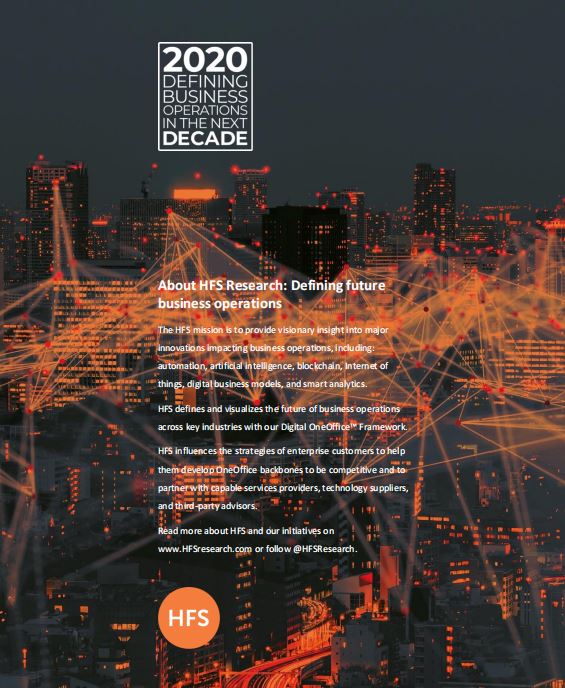HFS Highlight: WNS’ new Quote to Sustain and FIAB solutions aims to drive the Finance OneOffice Experience
HFS’ framework of the Digital OneOffice has become more important than ever during the pandemic. Businesses have been forced to face their siloed constructs of front, middle, and back office in the remote working world. The finance function has been especially hard hit, needing to play a dual role with protecting the business through cash preservation and working capital optimization, and driving the business with technology transformation to create better value for employees and end customers. 89% of finance executives in our recent study agree that finance has an important role to play in driving the OneOffice Organization. However, few have realized the vision, as finance has so far been crushed under managing transactional accounting and bookkeeping, and unable to make connections across the enterprise.
This “have-to-have” business environment has been well recognized by WNS, leading to its launch of two finance solutions that get to the heart of the Digital OneOffice concepts of data-driven internal alignment.
WNS reimagines the traditional boundaries of order-to-cash with ‘Quote-to-Sustain’
Over a number of years, the finance and accounting function has evolved from a process perspective, such as from receivables into to order-to-cash. While further back-office focused alignment with sales is underway for many organizations, HFS sees a strong need for O2C to expand upstream into the CRM space (lead-to-order) and downstream into after-sales services. In our recent study surveying 250 global F&A leaders, we found that nearly 40% respondents are prioritizing the upstream expansion of order-to-cash processes into the lead-to-order cycle, and from a technology perspective, into customer relationship management (CRM) systems . This marks a tangible investment towards getting to the OneOffice, and bringing finance out of its backoffice relegation.
This focus on internal alignment is at the heart of WNS’ new Quote to Sustain (QtS) solution. The goal, according to WNS’ F&A leader Krishnan Raghunathan, is not about combining multiple technologies and layering on a small capability, but instead, having one single platform that combines bots, intelligent workflow, and other digital technologies such as smart ordering and quotation management to create a better end to end stakeholder experience. QtS stitches together multiple third party technologies including Emagia and Highradius, and WNS’ own analytics and automation IP to build an integrated solution that goes across order fulfillment, billing, and receivables.
Key aspects of QtS that particularly resonated with HFS include:
- Play towards bridging the silos around O2C – QtS is designed with an eye on upstream and downstream dependencies of receivables processes, starting from the quote to order management, billing to cash application, and associated reporting and analytics activities.
- Output-based pricing – WNS is envisioning QtS as a Business Process as a Service, or BPaaS solution, where enterprise clients would move away from FTE-based pricing to unit based pricing with components such as automation, change management being built-in, and WNS committing to YoY savings.
- Focus on data sanguinity – Using WNS IP on data ingestion, QtS gets finance closer to having a single source of truth across various systems. There is a strong focus on curating and maintaining unified data, with externally validated data authentication (e.g. tax ids), and applying automation tools to speed up data ingestion and cleansing.
- Ecosystem approach – No one vendor or service provider can build everything in-house for complex enterprise business functions from a technology perspective. WNS has made the wise choice of combining its own IP around analytics, data management, and automation (such as WNS CFO TRAC), along with leading third-party tools and platforms in the receivables market. At the end of the day, connecting these dots makes it that much easier for F&A clients to adopt a solution that can be considered best-of-breed and well-integrated.
Finance becomes the data arbiter with WNS’ Financial Intelligence in a Box (FIAB)
End to end data management is a key goal for many finance leaders, but without the right set of technologies, skillsets, and data-driven culture, this has been an elusive goal for many. According to WNS, FIAB refers to a suite of techniques, applications and methods to uncover a box of tangible monetary gains for clients through rigorous and pragmatic research of accounting and financial data. Essentially, WNS’ analytics teams can analyze and build insights and dashboards that can significantly aid controllership and compliance efforts for client organizations. Examples of the type of advanced analytics that can be applied using FIAB techniques include audit & recovery analytics, forensic analytics, journal entry analytics, cash flow forecasting, working capital analytics, and control-room metrics.
The most innovative part of FIAB, as showcased to HFS, was the application of unstructured data analytics in processes where typically only quantitative data is looked at (such as the free text narrations in journal entries). For auditing use cases, the offering also solves the issue of sampling, as FIAB is able to analyze all transaction data to better determine targets for auditing. In a nutshell, with FIAB, WNS is bringing fresh thinking to how modern analytical techniques can impact the finance function.
The bottom-line: WNS’ new offerings bring us one step closer towards answering the ‘how’ of achieving the Finance OneOffice, underpinned by data
An internally aligned, data-driven finance function will be able to better serve internal and external stakeholders, making QtS and FIAB a worthy aspiration for WNS and potential F&A clients. Cost variablization is another reason this solution might resonate in the current market that prioritizes cash preservation. But ultimately, to take full value of offerings like QtS and FIAB, finance organizations will need to get out of their legacy mindsets and cultural silos. The need for finance transformation was always there, but now Covid-19 presents the burning platform to make elements of the OneOffice real.
